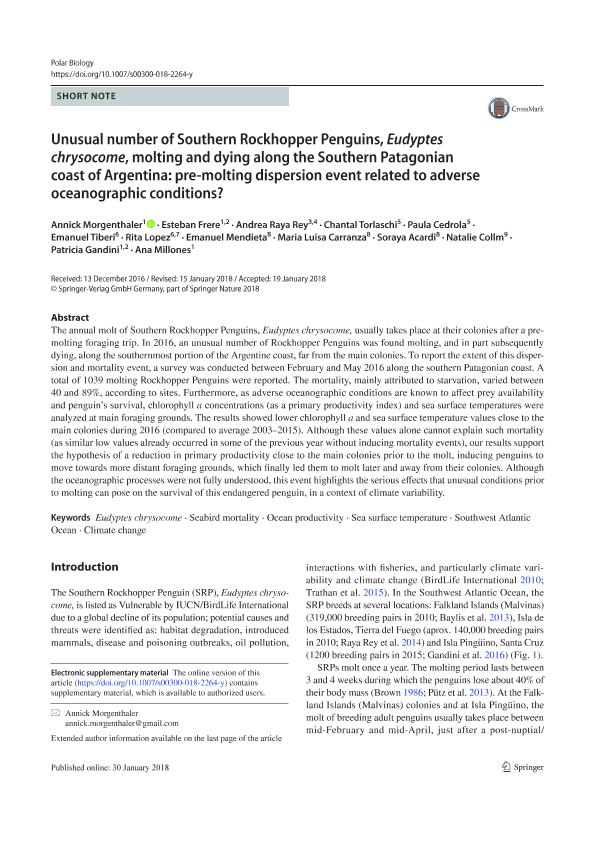Mostrar el registro sencillo del ítem
dc.contributor.author
Morgenthaler, Annick

dc.contributor.author
Frere, Esteban

dc.contributor.author
Raya Rey, Andrea Nélida

dc.contributor.author
Torlaschi, Chantal
dc.contributor.author
Cedrola, Paula
dc.contributor.author
Tiberi, Emanuel
dc.contributor.author
Lopez, Rita
dc.contributor.author
Mendieta, Emanuel
dc.contributor.author
Carranza, Maria Luisa
dc.contributor.author
Acardi, Soraya
dc.contributor.author
Collm, Natalia Sarita

dc.contributor.author
Gandini, Patricia Alejandra

dc.contributor.author
Millones, Ana
dc.date.available
2020-01-10T15:27:25Z
dc.date.issued
2018-05
dc.identifier.citation
Morgenthaler, Annick; Frere, Esteban; Raya Rey, Andrea Nélida; Torlaschi, Chantal; Cedrola, Paula; et al.; Unusual number of Southern Rockhopper Penguins, Eudyptes chrysocome, molting and dying along the Southern Patagonian coast of Argentina: pre-molting dispersion event related to adverse oceanographic conditions?; Springer; Polar Biology; 41; 5; 5-2018; 1041-1047
dc.identifier.issn
0722-4060
dc.identifier.uri
http://hdl.handle.net/11336/94297
dc.description.abstract
The annual molt of Southern Rockhopper Penguins, Eudyptes chrysocome, usually takes place at their colonies after a pre-molting foraging trip. In 2016, an unusual number of Rockhopper Penguins was found molting, and in part subsequently dying, along the southernmost portion of the Argentine coast, far from the main colonies. To report the extent of this dispersion and mortality event, a survey was conducted between February and May 2016 along the southern Patagonian coast. A total of 1039 molting Rockhopper Penguins were reported. The mortality, mainly attributed to starvation, varied between 40 and 89%, according to sites. Furthermore, as adverse oceanographic conditions are known to affect prey availability and penguin’s survival, chlorophyll a concentrations (as a primary productivity index) and sea surface temperatures were analyzed at main foraging grounds. The results showed lower chlorophyll a and sea surface temperature values close to the main colonies during 2016 (compared to average 2003–2015). Although these values alone cannot explain such mortality (as similar low values already occurred in some of the previous year without inducing mortality events), our results support the hypothesis of a reduction in primary productivity close to the main colonies prior to the molt, inducing penguins to move towards more distant foraging grounds, which finally led them to molt later and away from their colonies. Although the oceanographic processes were not fully understood, this event highlights the serious effects that unusual conditions prior to molting can pose on the survival of this endangered penguin, in a context of climate variability.
dc.format
application/pdf
dc.language.iso
eng
dc.publisher
Springer

dc.rights
info:eu-repo/semantics/openAccess
dc.rights.uri
https://creativecommons.org/licenses/by-nc-sa/2.5/ar/
dc.subject
CLIMATE CHANGE
dc.subject
EUDYPTES CHRYSOCOME
dc.subject
OCEAN PRODUCTIVITY
dc.subject
SEA SURFACE TEMPERATURE
dc.subject
SEABIRD MORTALITY
dc.subject
SOUTHWEST ATLANTIC OCEAN
dc.subject.classification
Ecología

dc.subject.classification
Ciencias Biológicas

dc.subject.classification
CIENCIAS NATURALES Y EXACTAS

dc.subject.classification
Ecología

dc.subject.classification
Ciencias Biológicas

dc.subject.classification
CIENCIAS NATURALES Y EXACTAS

dc.title
Unusual number of Southern Rockhopper Penguins, Eudyptes chrysocome, molting and dying along the Southern Patagonian coast of Argentina: pre-molting dispersion event related to adverse oceanographic conditions?
dc.type
info:eu-repo/semantics/article
dc.type
info:ar-repo/semantics/artículo
dc.type
info:eu-repo/semantics/publishedVersion
dc.date.updated
2019-10-17T14:04:16Z
dc.journal.volume
41
dc.journal.number
5
dc.journal.pagination
1041-1047
dc.journal.pais
Alemania

dc.journal.ciudad
Berlin
dc.description.fil
Fil: Morgenthaler, Annick. Universidad Nacional de la Patagonia Austral; Argentina
dc.description.fil
Fil: Frere, Esteban. Consejo Nacional de Investigaciones Científicas y Técnicas; Argentina. Universidad Nacional de la Patagonia Austral; Argentina
dc.description.fil
Fil: Raya Rey, Andrea Nélida. Consejo Nacional de Investigaciones Científicas y Técnicas. Centro Austral de Investigaciones Científicas; Argentina. Universidad Nacional de Tierra del Fuego; Argentina
dc.description.fil
Fil: Torlaschi, Chantal. Consejo Agrario Provincial. Delegación Puerto Deseado; Argentina
dc.description.fil
Fil: Cedrola, Paula. Consejo Agrario Provincial. Delegación Puerto Deseado; Argentina
dc.description.fil
Fil: Tiberi, Emanuel. Asociación Ambiente Sur; Argentina
dc.description.fil
Fil: Lopez, Rita. Dirección Agencia Ambiental Municipal; Argentina. Asociación Ambiente Sur; Argentina
dc.description.fil
Fil: Mendieta, Emanuel. Secretaría de Ambiente, Desarrollo Sostenible y Cambio Climático. Dirección General de Áreas Protegidas y Biodiversidad; Argentina
dc.description.fil
Fil: Carranza, Maria Luisa. Secretaría de Ambiente, Desarrollo Sostenible y Cambio Climático. Dirección General de Áreas Protegidas y Biodiversidad; Argentina
dc.description.fil
Fil: Acardi, Soraya. Secretaría de Ambiente, Desarrollo Sostenible y Cambio Climático. Dirección General de Áreas Protegidas y Biodiversidad; Argentina
dc.description.fil
Fil: Collm, Natalia Sarita. Universidad Nacional de la Patagonia Austral; Argentina. Consejo Nacional de Investigaciones Científicas y Técnicas; Argentina
dc.description.fil
Fil: Gandini, Patricia Alejandra. Consejo Nacional de Investigaciones Científicas y Técnicas; Argentina. Universidad Nacional de la Patagonia Austral; Argentina
dc.description.fil
Fil: Millones, Ana. Universidad Nacional de la Patagonia Austral; Argentina
dc.journal.title
Polar Biology

dc.relation.alternativeid
info:eu-repo/semantics/altIdentifier/url/http://link.springer.com/10.1007/s00300-018-2264-y
dc.relation.alternativeid
info:eu-repo/semantics/altIdentifier/doi/http://dx.doi.org/10.1007/s00300-018-2264-y
Archivos asociados
